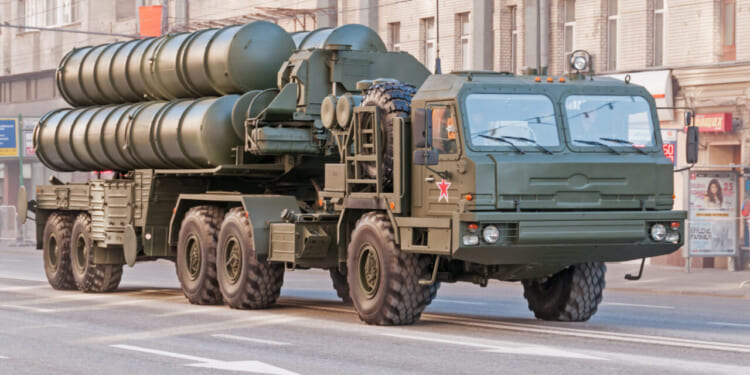Kyiv has prioritized taking out Moscow’s air defense assets as part of its defensive strategy.
Russia’s advanced surface-to-air missile (SAM) systems have proven to be a major roadblock for Ukraine’s war efforts amidst the invasion. Over the last three-plus years, Kyiv has prioritized taking out Moscow’s slew of air defense assets in order to make headway in its defensive strategy. Earlier this month, Ukrainian special forces reportedly carried out a precision strike on multiple Russian assets, including command and radar components of its S-400 “Triumf” air defense division. According to Ukraine’s Defense Intelligence Directorate, the attack successfully took out a 92N6E multi-function radar and the power supply system supporting the command post. As the war rages on, Kyiv will undoubtedly attempt to destroy additional SAM components.
The Russian S-400 Triumf
The Triumf was conceptualized during the Cold War to be the eventual successor to the S-200 missile system. However, the former Soviet government did not officially greenlight the new system until right before the USSR collapsed. It wasn’t until the late 1990s that the newly installed Russian Air Force was able to test the S-400 and ultimately revive it. By 2007, the Triumf officially reached operational capacity. Designated by NATO as the SA-21 “Growler,” the Russian SAM system is capable of taking out drones, cruise missiles, and even aircraft. As the fourth-generation product of this air defense family, the S-400 is considered to be quite advanced. In fact, the Triumf’s capabilities actually put it on par with its widely recognized American-made Patriot counterpart.
While the S-300 remains in service, its successor features more enhanced functions that make it more precise. Specifically, the S-400’s system combines three different arrays that broadcast on various frequency bands to track, target, and locate aircraft. The SAM can even detect America’s fifth-generation F-22 Raptor and F-35 Lightning II fighter jets. As explained by Sandboxx News, “Modern stealth fighters are designed to delay or prevent detection from higher frequency radar arrays broadcasting in parts of the S, C, X, and Ku bands, because these systems are capable of providing a ‘weapons-grade lock,’ in other words, radar arrays that can guide a missile to a target. Lower frequency radar arrays leveraging the L or S bands are not capable of guiding weapons with this sort of accuracy — but are capable of spotting stealth fighters.”
Although the S-400 is considered to represent one of the most advanced air defense systems across the globe, the platform has not performed as well as expected in Ukraine. Multiple S-400 units have been destroyed in the ongoing invasion, including by aging Western weapons, the top-tier system should have been able to engage and counter. Last summer, Ukraine’s security service and navy carried out a successful attack targeting a Russian facility in Crimea. Using a host of lethal drones and cruise missiles, Kyiv was reportedly able to disable both Russia’s S-300 and S-400 systems by using Neptune missiles in the assault. If the Triumf really is as formidable as the Kremlin likes to tout, it should not have been this simple for Kyiv to take them out.
About the Author: Maya Carlin
Maya Carlin, National Security Writer with The National Interest, is an analyst with the Center for Security Policy and a former Anna Sobol Levy Fellow at IDC Herzliya in Israel. She has by-lines in many publications, including The National Interest, Jerusalem Post, and Times of Israel. You can follow her on Twitter: @MayaCarlin. Carlin has over 1,000 articles published over the last several years on various defense issues.
Image: Shujaa_777 / Shutterstock.com
















